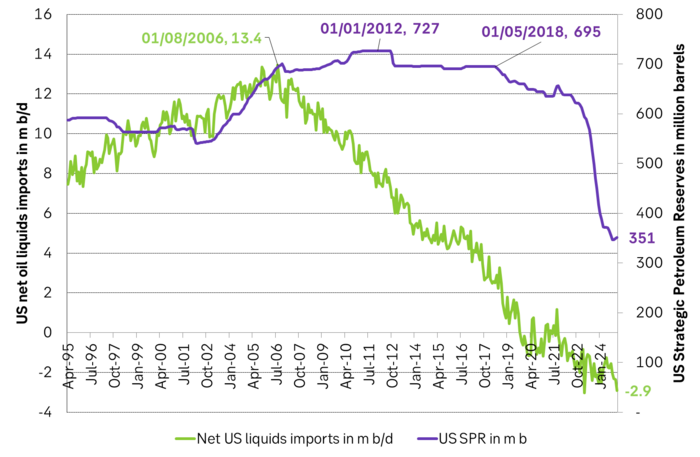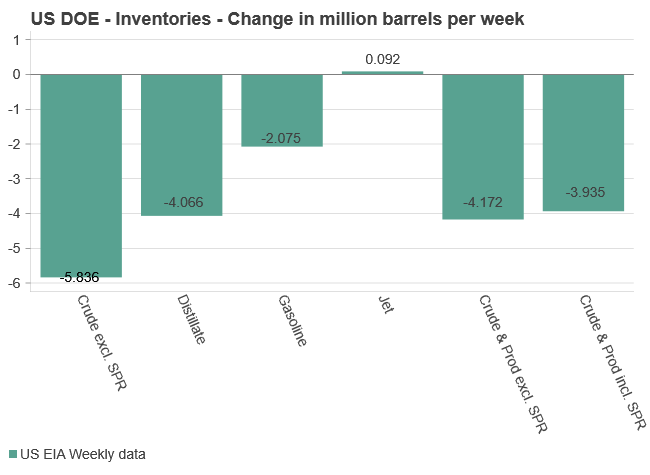Analys
Reloading the US ’oil-gun’ (SPR) will have to wait until next downturn

Brent crude traded down 0.4% earlier this morning to USD 91.8/b but is unchanged at USD 92.2/b at the moment. Early softness was probably mostly about general market weakness than anything specific to oil as copper is down 0.7% while European equities are down 0.3%. No one knows the consequences of what a ground invasion of Gaza by Israel may bring except that it will be very, very bad for Palestinians, for Middle East politics for geopolitics and potentially destabilizing for global oil markets. As of yet the oil market seems to struggle with how to price the situation with fairly little risk premium priced in at the moment as far as we can see. Global financial markets however seems to have a clearer bearish take on this. Though rallying US rates and struggling Chinese property market may be part of that.

The US has drawn down its Strategic Petroleum Reserves (SPR) over the latest years to only 50% of capacity. Crude oil prices would probably have to rally to USD 150-200/b before the US would consider pushing another 100-200 m b from SPR into the commercial market. As such the fire-power of its SPR as a geopolitical oil pricing tool is now somewhat muted. The US would probably happily re-load its SPR but it is very difficult to do so while the global oil market is running a deficit. It will have to wait to the next oil market downturn. But that also implies that the next downturn will likely be fairly short-lived and also fairly shallow. Unless of course the US chooses to forgo the opportunity.
The US has drawn down its Strategic Petroleum Reserves (SPR) to only 50% of capacity over the latest years. Most of the draw-down was in response to the crisis in Ukraine as it was invaded by Russia with loss of oil supply from Russia thereafter.
The US has however no problems with security of supply of crude oil. US refineries have preferences for different kinds of crude slates and as a result it still imports significant volumes of crude of different qualities. But overall it is a net exporter of hydrocarbon liquids. It doesn’t need all that big strategic reserves as a security of supply any more. Following the oil crisis in the early 70ies the OECD countries created the International Energy Agency where all its members aimed to have some 100 days of forward oil import coverage. With US oil production at steady decline since the 70ies the US reached a peak in net imports of 13.4 m b/d in 2006. As such it should have held an SPR of 1340 million barrels. It kept building its SPR which peaked at 727 m b in 2012. But since 2006 its net imports have been in sharp decline and today it has a net export of 2.9 m b/d.
Essentially the US doesn’t need such a sizable SPR any more to secure coverage of its daily consumption. As a result it started to draw down its SPR well before the Russian invasion of Ukraine in February 2022. But then of course it fell fast and is today at 351 m b or about 50% of capacity.
The US is the largest oil consumer in the world. As such it is highly vulnerable to the price level of oil. The US SPR today is much more of a geopolitical tool than a security of supply tool. It’s a tool to intervene in the global oil market. To intervene in the price setting of oil. The US SPR is now drawn down to 50% but it still holds a sizable amount of oil. But it is little in comparison to the firepower of OPEC. Saudi Arabia can lower its production by 1 m b/d for one year and it will have eradicated 365 million barrels in global oil inventories. And then it can the same the year after and then the year after that again.
The US has now fired one big bullet of SPR inventory draws. It really helped to balance the global oil market last year and prevented oil prices from going sky high. With 350 m b left in its SPR it can still do more if needed. But the situation would likely need to be way more critical before the US would consider pushing yet another 100-200 m b of oil from its SPR into the global commercial oil market. An oil price of USD 150-200/b would probably be needed before it would do so.
With new geopolitical realities the US probably will want to rebuild its SPR to higher levels as it is now an important geopolitical tool and an oil price management tool. But rebuilding the SPR now while the global oil market is running a deficit is a no-go as we see it.
An oil market downturn, a global recession, a global oil market surplus where OPEC no longer want to defend the oil price with reduced supply is needed for the US to be able to refill its SPR again unless it wants to drive the oil price significantly higher.
But this also implies that the next oil price downturn will likely be short-lived and shallow as the US will have to use that opportunity to rebuild its SPR. It’s kind off like reloading its geopolitical oil gun. If it instead decides to forgo such an opportunity then it will have to accept that its geopolitical maneuverability in the global oil market stays muted.
Net US oil imports in m b/d and US Strategic Petroleum Reserves (SPR) in million barrels. The US doesn’t need strategic petroleum reserves for the sake of security of supply any more. But it is a great geopolitical energy-tool to intervene in the price setting of oil in the global market place.

Analys
Tightening fundamentals – bullish inventories from DOE

The latest weekly report from the US DOE showed a substantial drawdown across key petroleum categories, adding more upside potential to the fundamental picture.

Commercial crude inventories (excl. SPR) fell by 5.8 million barrels, bringing total inventories down to 415.1 million barrels. Now sitting 11% below the five-year seasonal norm and placed in the lowest 2015-2022 range (see picture below).
Product inventories also tightened further last week. Gasoline inventories declined by 2.1 million barrels, with reductions seen in both finished gasoline and blending components. Current gasoline levels are about 3% below the five-year average for this time of year.
Among products, the most notable move came in diesel, where inventories dropped by almost 4.1 million barrels, deepening the deficit to around 20% below seasonal norms – continuing to underscore the persistent supply tightness in diesel markets.
The only area of inventory growth was in propane/propylene, which posted a significant 5.1-million-barrel build and now stands 9% above the five-year average.
Total commercial petroleum inventories (crude plus refined products) declined by 4.2 million barrels on the week, reinforcing the overall tightening of US crude and products.


Analys
Bombs to ”ceasefire” in hours – Brent below $70

A classic case of “buy the rumor, sell the news” played out in oil markets, as Brent crude has dropped sharply – down nearly USD 10 per barrel since yesterday evening – following Iran’s retaliatory strike on a U.S. air base in Qatar. The immediate reaction was: “That was it?” The strike followed a carefully calibrated, non-escalatory playbook, avoiding direct threats to energy infrastructure or disruption of shipping through the Strait of Hormuz – thus calming worst-case fears.

After Monday morning’s sharp spike to USD 81.4 per barrel, triggered by the U.S. bombing of Iranian nuclear facilities, oil prices drifted sideways in anticipation of a potential Iranian response. That response came with advance warning and caused limited physical damage. Early this morning, both the U.S. President and Iranian state media announced a ceasefire, effectively placing a lid on the immediate conflict risk – at least for now.
As a result, Brent crude has now fallen by a total of USD 12 from Monday’s peak, currently trading around USD 69 per barrel.
Looking beyond geopolitics, the market will now shift its focus to the upcoming OPEC+ meeting in early July. Saudi Arabia’s decision to increase output earlier this year – despite falling prices – has drawn renewed attention considering recent developments. Some suggest this was a response to U.S. pressure to offset potential Iranian supply losses.
However, consensus is that the move was driven more by internal OPEC+ dynamics. After years of curbing production to support prices, Riyadh had grown frustrated with quota-busting by several members (notably Kazakhstan). With Saudi Arabia cutting up to 2 million barrels per day – roughly 2% of global supply – returns were diminishing, and the risk of losing market share was rising. The production increase is widely seen as an effort to reassert leadership and restore discipline within the group.
That said, the FT recently stated that, the Saudis remain wary of past missteps. In 2018, Riyadh ramped up output at Trump’s request ahead of Iran sanctions, only to see prices collapse when the U.S. granted broad waivers – triggering oversupply. Officials have reportedly made it clear they don’t intend to repeat that mistake.
The recent visit by President Trump to Saudi Arabia, which included agreements on AI, defense, and nuclear cooperation, suggests a broader strategic alignment. This has fueled speculation about a quiet “pump-for-politics” deal behind recent production moves.
Looking ahead, oil prices have now retraced the entire rally sparked by the June 13 Israel–Iran escalation. This retreat provides more political and policy space for both the U.S. and Saudi Arabia. Specifically, it makes it easier for Riyadh to scale back its three recent production hikes of 411,000 barrels each, potentially returning to more moderate increases of 137,000 barrels for August and September.
In short: with no major loss of Iranian supply to the market, OPEC+ – led by Saudi Arabia – no longer needs to compensate for a disruption that hasn’t materialized, especially not to please the U.S. at the cost of its own market strategy. As the Saudis themselves have signaled, they are unlikely to repeat previous mistakes.
Conclusion: With Brent now in the high USD 60s, buying oil looks fundamentally justified. The geopolitical premium has deflated, but tensions between Israel and Iran remain unresolved – and the risk of missteps and renewed escalation still lingers. In fact, even this morning, reports have emerged of renewed missile fire despite the declared “truce.” The path forward may be calmer – but it is far from stable.
Analys
A muted price reaction. Market looks relaxed, but it is still on edge waiting for what Iran will do

Brent crossed the 80-line this morning but quickly fell back assigning limited probability for Iran choosing to close the Strait of Hormuz. Brent traded in a range of USD 70.56 – 79.04/b last week as the market fluctuated between ”Iran wants a deal” and ”US is about to attack Iran”. At the end of the week though, Donald Trump managed to convince markets (and probably also Iran) that he would make a decision within two weeks. I.e. no imminent attack. Previously when when he has talked about ”making a decision within two weeks” he has often ended up doing nothing in the end. The oil market relaxed as a result and the week ended at USD 77.01/b which is just USD 6/b above the year to date average of USD 71/b.

Brent jumped to USD 81.4/b this morning, the highest since mid-January, but then quickly fell back to a current price of USD 78.2/b which is only up 1.5% versus the close on Friday. As such the market is pricing a fairly low probability that Iran will actually close the Strait of Hormuz. Probably because it will hurt Iranian oil exports as well as the global oil market.
It was however all smoke and mirrors. Deception. The US attacked Iran on Saturday. The attack involved 125 warplanes, submarines and surface warships and 14 bunker buster bombs were dropped on Iranian nuclear sites including Fordow, Natanz and Isfahan. In response the Iranian Parliament voted in support of closing the Strait of Hormuz where some 17 mb of crude and products is transported to the global market every day plus significant volumes of LNG. This is however merely an advise to the Supreme leader Ayatollah Ali Khamenei and the Supreme National Security Council which sits with the final and actual decision.
No supply of oil is lost yet. It is about the risk of Iran closing the Strait of Hormuz or not. So far not a single drop of oil supply has been lost to the global market. The price at the moment is all about the assessed risk of loss of supply. Will Iran choose to choke of the Strait of Hormuz or not? That is the big question. It would be painful for US consumers, for Donald Trump’s voter base, for the global economy but also for Iran and its population which relies on oil exports and income from selling oil out of that Strait as well. As such it is not a no-brainer choice for Iran to close the Strait for oil exports. And looking at the il price this morning it is clear that the oil market doesn’t assign a very high probability of it happening. It is however probably well within the capability of Iran to close the Strait off with rockets, mines, air-drones and possibly sea-drones. Just look at how Ukraine has been able to control and damage the Russian Black Sea fleet.
What to do about the highly enriched uranium which has gone missing? While the US and Israel can celebrate their destruction of Iranian nuclear facilities they are also scratching their heads over what to do with the lost Iranian nuclear material. Iran had 408 kg of highly enriched uranium (IAEA). Almost weapons grade. Enough for some 10 nuclear warheads. It seems to have been transported out of Fordow before the attack this weekend.
The market is still on edge. USD 80-something/b seems sensible while we wait. The oil market reaction to this weekend’s events is very muted so far. The market is still on edge awaiting what Iran will do. Because Iran will do something. But what and when? An oil price of 80-something seems like a sensible level until something do happen.
-

 Nyheter3 veckor sedan
Nyheter3 veckor sedanStor uppsida i Lappland Guldprospekterings aktie enligt analys
-

 Nyheter4 veckor sedan
Nyheter4 veckor sedanBrookfield ska bygga ett AI-datacenter på hela 750 MW i Strängnäs
-

 Nyheter4 veckor sedan
Nyheter4 veckor sedanSommaren inleds med sol och varierande elpriser
-

 Nyheter3 veckor sedan
Nyheter3 veckor sedanSilverpriset släpar efter guldets utveckling, har mer uppsida
-

 Analys4 veckor sedan
Analys4 veckor sedanBrent needs to fall to USD 58/b to make cheating unprofitable for Kazakhstan
-

 Nyheter4 veckor sedan
Nyheter4 veckor sedanTradingfirman XTX Markets bygger datacenter i finska Kajana för 1 miljard euro
-

 Nyheter2 veckor sedan
Nyheter2 veckor sedanUppgången i oljepriset planade ut under helgen
-

 Nyheter2 veckor sedan
Nyheter2 veckor sedanLåga elpriser i sommar – men mellersta Sverige får en ökning









